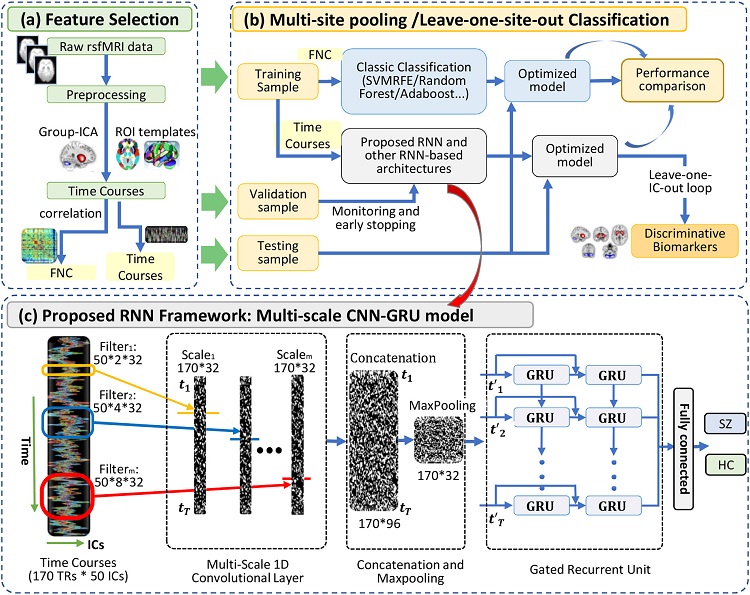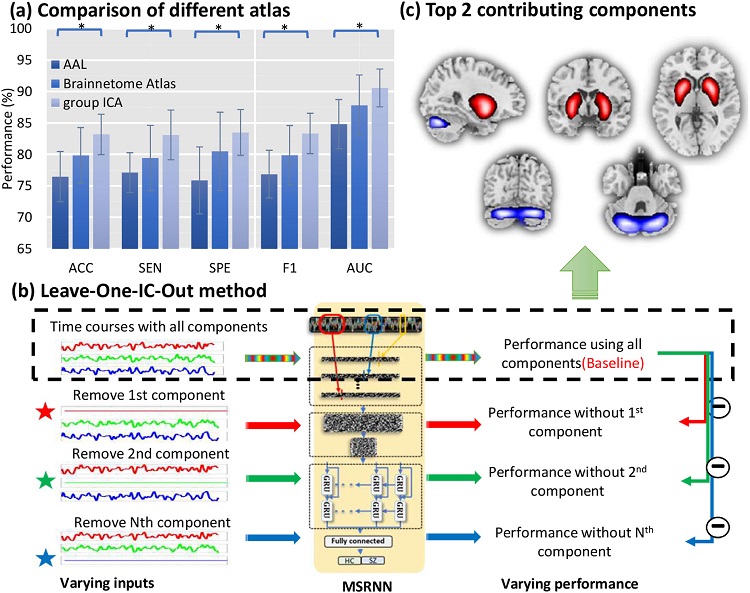- Home >> Latest News
Discriminating schizophrenia using recurrent neural network applied on time courses of multi-site FMRI data
Weizheng Yan a,b, Vince Calhoun c, Ming Song a,b, Yue Cui a,b, Hao Yan d,e, Shengfeng Liu a,b, Lingzhong Fan a,b, Nianming Zuo a,b, Zhengyi Yang a,b, Kaibin Xu a,b, Jun Yan d,e, Luxian Lv f,g, Jun Chen h, Yunchun Chen i, Hua Guo j, Peng Li d,e, Lin Lu d,e, Ping Wan j, Huaning Wang i, Huiling Wang h, Yongfeng Yang f,g,k, Hongxing Zhang f,l, Dai Zhang d,e,m, Tianzi Jiang a,b,k,n,o,*, Jing Sui a,b,o,*
a National Laboratory of Pattern Recognition and Brainnetome Center, Institute of Automation, Chinese Academy of Sciences, Beijing 100190, China
b University of Chinese Academy of Sciences, Beijing 100049, China
c Tri-Institutional Center for Translational Research in Neuroimaging and Data Science (TReNDS) Center, Atlanta 30303, GA, USA
d Peking University Sixth Hospital, Institute of Mental Health, Beijing 100191, China
e Key Laboratory of Mental Health, Ministry of Health, Peking University, Beijing 100191, China
f Department of Psychiatry, Henan Mental Hospital, The Second Affiliated Hospital of Xinxiang Medical University, Xinxiang 453002, Henan, China
g Henan Key Lab of Biological Psychiatry, Xinxiang Medical University, Xinxiang 453002, Henan, China
h Department of Radiology, Renmin Hospital of Wuhan University,Wuhan 430060, Hubei, China
i Department of Psychiatry, Xijing Hospital, The Fourth Military Medical University, Xi’an 710032, Shaanxi, China
j Zhumadian Psychiatric Hospital, Zhumadian 463000, Henan, China
k Key Laboratory for NeuroInformation of Ministry of Education, School of Life Science and Technology, University of Electronic Science and Technology of China, Chengdu 610054, Sichuan, China
l Department of Psychology, Xinxiang Medical University, Xinxiang 453002, Henan, China
m Center for Life Sciences/PKU-IDG/McGovern Institute for Brain Research, Peking University, Beijing 100871, China
n Queensland Brain Institute, University of Queensland, Brisbane 4072, QLD, Australia
o CAS Center for Excellence in Brain Science and Intelligence Technology, Institute of Automation, Chinese Academy of Sciences, Beijing 100190, China
Abstract
Background: Current fMRI-based classification approaches mostly use functional connectivity or spatial maps as input, instead of exploring the dynamic time courses directly, which does not leverage the full temporal information.
Methods: Motivated by the ability of recurrent neural networks (RNN) in capturing dynamic information of time sequences, we propose a multi-scale RNN model, which enables classification between 558 schizophrenia and 542 healthy controls by using timecourses of fMRI independent components (ICs) directly. To increase interpretability, we also propose a leave-one-IC-out looping strategy for estimating the top contributing ICs.
Findings: Accuracies of 83·2% and 80·2%were obtained respectively for themulti-site pooling and leave-one-siteout transfer classification. Subsequently, dorsal striatum and cerebellum components contribute the top two group-discriminative timecourses,which is true evenwhen adopting different brain atlases to extract time series.
Interpretation: This is the first attempt to apply a multi-scale RNN model directly on fMRI time courses for classification of mental disorders, and shows the potential for multi-scale RNN-based neuroimaging classifications.
|
| Fig. 1. The framework of the Multi-scale RNN model in distinguishing schizophrenia patients from healthy controls. (a) Data preprocessing and feature selection. All rsfMRI data were preprocessed using the standard procedure. Time courses were then extracted using group-ICA/AAL/Brainnetome Atlas respectively. (b) The TCs/FNC data were randomly split into training, validation and testing sets. In multi-site pooling classification, all seven datasets were pooled together, and then k-fold cross-validation strategies were used for evaluating classification performance. In leave-one-site-out transfer prediction, the samples of a given imaging site were left for testing, and the samples of other sites were used for training. The performance of conventional methods (including Adaboost, Random Forest and SVM) and various RNN-based models were used for comparison. The most discriminative components were found by using leave-one-IC-out method. (c) Details of the MsRNN classification model. Three different scales convolutional filters were used for extracting of spatial features from time courses. The extracted features were then concatenated, pooling, and sent to stacked GRU module. |
|
| Fig. 2. Comparison of different atlas and Leave-One-IC-Out method. (a) The MsRNN classification results using three different feature selection methods. * P b .05 (two-sample t-test). (b) Leave-one-IC-out method for estimating the contribution of each IC. (c) Top two discriminative independent components discovered using the leave-one-IC-out method. |


